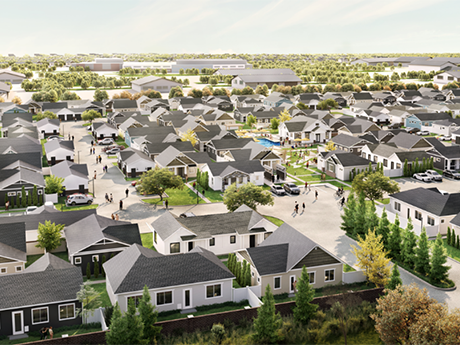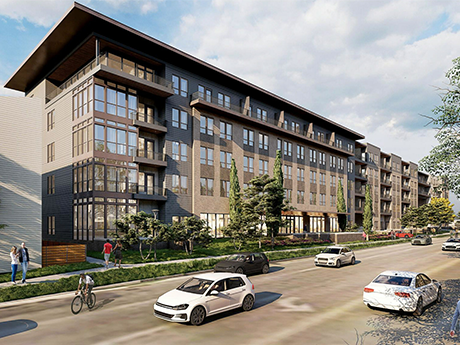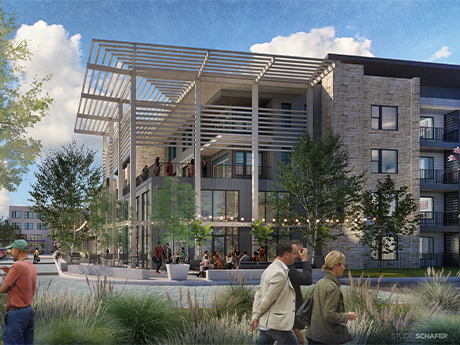The average effective rent in the Dallas-Fort Worth apartment market declined by 0.5 percent between the third quarter of 2022 and the third quarter of this year, the first drop in rent since late 2021, according to Newmark. Whether this is a blip on the radar screen or an inflection point remains to be seen.
Oversupply is contributing to the drop in rents. Newmark reports that developers opened 25,386 new units in the past 12 months as of the third quarter of 2023, compared with 8,742 units absorbed during the same period.
“Dallas-Fort Worth has a lot of supply, there is no way around it,” says Asher Hall, who is a senior director with Cushman & Wakefield’s Sunbelt Multifamily Advisory Group. Hall focuses on multifamily investment sales in the DFW metroplex.
“But when you look at it from a percentage of existing inventory, it is still a very healthy number at approximately 7 percent of total inventory, and that number is not concerning at all.”
By comparison, Atlanta developers are building 6.8 percent of that market’s total inventory, according to Matthews. In downtown Austin, about 2,800 units are under construction, accounting for 45 percent of that metro’s total apartment stock.
Although the ratio of new units to total inventory is not a long-term concern for investors, DFW operators are still challenged by the current supply-demand imbalance. Many owners of new projects are scrambling during the lease-up period, leading to significant concessions. For investors, no one can, or would want to, buy now because of the run-up in interest rates and high costs, namely property insurance.
These themes may have the market frozen at present, but this is the Dallas-Fort Worth metroplex, viewed by most as unstoppable. It is among the fastest-growing urban areas in the country.
According to the U.S. Census Bureau, the population of the DFW metro area grew by 170,396 residents between 2021 and 2022, the biggest increase nationally. That’s akin to the population of a city like Shreveport, Louisiana, or Eugene, Oregon, moving into the area in just one year.
“The latest population growth estimates predict that the DFW population will double in the next 30 years, growing by another 7.8 million people,” says Greg Smith, senior managing director with Berkadia Dallas. “This translates to the need for approximately 100,000 new homes each year, including for-sale and rental properties.”
Rent Growth Varies by Submarket
While the average effective rent for the DFW market as a whole declined in the third quarter, some submarkets defied the trend, explains Bill Miller, senior managing director in the Dallas office of JLL Capital Markets Americas and coleader of JLL’s National Multi-housing Group.
For example, the average effective rent in Northwest Dallas grew 5.8 percent year-over-year in the third quarter, compared with 4.9 percent in East Dallas, 4.2 percent in Far East Dallas and 2.2 percent in Intown Dallas, Miller notes.
Conversely, the average effective rent decreased by 0.4 percent in Grand Prairie during the same period.
According to RealPage, asking rents also dropped by 2.5 percent in Northeast Fort Worth/North Richland Hills, and in other suburbs, such as Allen/McKinney, rents fell 2.3 percent. These are year-over-year figures ending July 2023.
The metro area’s occupancy rate dropped 1.6 percent in the past year. Per, Newmark, the rate as of the third quarter of this year was 93.4 percent, versus 95 percent one year prior.
Rent changes are dependent, among other factors, on new supply, and to the north, there’s been a lot of it. In Frisco, for example, inventory has grown a staggering 258 percent over the past 10 years, according to RealPage. During that period, 22,284 new units have opened. New deliveries in Frisco primarily fall into the Class A category.
Average asking rents in Frisco ranged from $1,246 to $2,290, as of Nov. 30, according to Rent.com. In the past year, the average asking rent decreased 4 percent for a studio apartment compared with 2 percent for a one-bedroom unit and 5 percent for a two-bedroom floor plan.

Brian O’Boyle Jr., vice chairman of Newmark’s Dallas office, reports that virtually all developers in the northern suburbs of DFW such as Frisco, Prosper, Celina, McKinney, Melissa and Anna are building high-rent, Class A properties. He says in Allen and McKinney, developers are building 11,000 units at the moment. In Frisco, 8,000 units are under construction, and Denton builders are working on 4,300 units.
Supply Drives Up Concessions
With rents softening and supply outpacing demand for the short term, concessions are common. Owners at properties that account for 31 percent of DFW’s total inventory are offering concessions, according to Miller.
He says Class A assets are offering the highest. Forty percent of total units in this class are offering rent discounts of 5.9 percent, he says. Thirty percent of Class B and C units are offering discounts of 4.3 percent.
“One of the main reasons Class A product ranks higher in offering concessions is that it is very common for newly delivered product in the DFW market to offer one-time concessions during stabilization,” explains Miller. “Class A product makes up roughly 45 percent of total inventory while also being the least affordable.”
O’Boyle adds that in today’s market, concessions don’t always end after lease-up. “Owners of new construction properties typically offer four to six weeks of free rent during lease-up, but we are seeing instances of properties that have been stabilized and yet are unable to eliminate concessions.” Today’s bad news, however, is fodder for a rosier tomorrow.
“When you look at supply going forward, it is likely going to dramatically taper off as we look to 2025 and beyond,” says Hall.
New starts are already decreasing. According to RealPage, the number of multifamily permits in Dallas decreased by 1,053 between August and September. Nationally, multifamily permitting was 31.5 percent lower than one year prior, as of September.
“We have a glut of supply that will need to be absorbed until then, including nearly 49,000 units expected to deliver between now and the third quarter of 2024. But with the lack of developers going vertical today, it is going to provide a very attractive supply-demand imbalance for years to come.”
O’Boyle concurs and says Dallas-Fort Worth will withstand today’s headwinds thanks to the strength of the local economy.
“From a confidence standpoint, we continue to see growth in job and population numbers, as well as continuing corporate relocations,” says O’Boyle. “Through September of this year, DFW added more than 178,000 jobs. A lack of new starts in 2023 and 2024 is anticipated to create tremendous gains in rental rates into 2025 and 2026 and beyond.”
RealPage, the data provider for Newmark’s report, forecasts a 2.4 percent increase in effective rent over the next year for the entire metropolitan statistical area (MSA). Parsing rent growth predictions by submarkets, the clear winners are expected to be Northwest Dallas with an estimated rent growth figure of 5.7 percent next year and Southeast Dallas at 5 percent.
Development Trends: Present and Future
Construction activity follows job growth in Dallas. “The North Dallas suburbs have a lot of supply to chew through over the coming 12 to 18 months, and we’ve also seen a boom within mid-cities locations like Mansfield and Grand Prairie,” says Hall.
Development is most notably growing in multiple pockets along the Dallas North Tollway. In October, the NRP Group and H.I.G. Realty Partners broke ground on Diamond Flats in the northwest suburb of Carrollton. The 331-unit project is slated for a 2025 delivery. The development team was attracted to local employment and entertain hubs, such as Legacy West, Hall Office Park, The Star in Frisco and the headquarters of companies including Toyota and Frito Lay. The Star is the 91-acre campus of the Dallas Cowboy’s world headquarters. Legacy West is a lifestyle retail center in Plano.
“The expansion of Legacy West and Hall Office Park is driving up the demand for housing in this area,” says Alena Savera, vice president of development at The NRP Group. “However, there are very few multifamily sites available, and cities in the area have little interest in rezoning land to multifamily. Due to the high barriers to entry for apartments, Diamond Flats will provide much-needed rent options in Flats will provide much-needed rent options in an area where home prices are skyrocketing.”
On the Fort Worth side of the metroplex, supply has been concentrated in north and southwest Fort Worth. Most municipalities in this area want to steer developers away from standalone apartment communities and toward mixed-used projects, explains Hall.
Historically, Fort Worth may have been viewed as Dallas’ little sister. Today, however, this city is developing a personality all its own.
The Texas A&M University system broke ground this summer on a $150 million, eight-story law and education building in Fort Worth. The city and Tarrant County are collaborating with Texas A&M to build two more campus buildings over four city blocks. The law and education building will be completed by 2025, and the remaining buildings are slated for a 2027 completion.
Hillwood, led by Ross Perot Jr., recently purchased an entire city block for future development in downtown Fort Worth that is next to the Texas A&M site. Walsh Ranch is another multi-use project expected to put Fort Worth on the map.
Republic Property Group began developing the 7,200-acre site in 2016. Uses include 15,000 single-family residential lots, 9 million square feet of commercial or mixed-use space, 4,000 multifamily units, eight elementary schools, two middle schools and one high school. This project is estimated to be fully built out by approximately 2050.

“These massive projects have spurred development on the multifamily side,” says Hall. “Ten years ago, the perception was that Fort Worth was a suburb of Dallas, but the view has changed as more and more groups are realizing that Fort Worth on its own is one of the largest cities in the country, which often gets overlooked,” says Hall, adding that there are $2.3 billion worth of projects under construction or in the pipeline in Fort Worth alone.
“When you see data like that, it is hard not to view Fort Worth separately. As these develop- ments have come online and as Fort Worth has continued to grow, it has brought a new view on Fort Worth and brings me confidence that the market can stand on its own.”
Some Renters Want Neighborhoods With Character
While substantial projects continue in Fort Worth and to the north, some developers are courting a different type of demand in other areas of the metro. The Flynn at Live Oak, for example, is under construction now in East Dallas. Conor Commercial Real Estate is developing the 327-unit community designed by Merriman Anderson Architects.
Jason Young, vice president of multifamily with Conor Commercial Real Estate, says that the area offers renters an alternative to the high-end style of the metro’s northern rings.
East Dallas is one of the older parts of Dallas that has seen an organic resurgence over the past 10 years, he points out.
“For apartment renters, East Dallas used to be a low-cost alternative to living in Uptown or Downtown where many renters worked. New living options in Uptown are now predominantly high-rises, pushing rents higher and creating more congestion,” says Young.
“As a result, young professionals have started migrating to East Dallas due to its more genuine neighborhood appeal, as well as its proximity to Lower Greenville and Henderson avenues with their restaurants and bars, which have experienced their own second renaissance in recent years,” adds Young.
Those Who Can’t Buy, Rent
Miller says high home prices and a low single-family home inventory combined with population and job growth are indicators of sustained demand for rental homes. He adds that the median home price in the market is $400,869.
“One growing segment of the market is single-family rental and built-to-rent (BTR) product,” adds Smith. “SFR and BTR don’t dominate the landscape, but BTR is the highest growth segment by percentage as renters are finding it difficult to buy homes. Long-term renters find this product attractive as a way to upgrade their residential experience.”
In November, the Empire Group of Cos. closed a $72.8 million loan and broke ground on a BTR project named Village at Golden Triangle. Located 14 miles north of downtown Fort Worth, the project is the Scottsdale, Arizona-based company’s first development in Dallas-Fort Worth. The project will consist of 317 units on about 30 acres.
“When it comes to population, Dallas-Fort Worth continues to be the fastest-growing large MSA in the country on an absolute basis,” says Randy Grudzinski, partner at the Empire Group of Cos.
“This rapid growth in in-migration and household formation demands the construction of new single-family housing. But because mortgage rates recently hit 8 percent, the highest since 2000, the gap between a monthly payment to rent versus to buy has also hit a record high. This is driving more people to choose single-family renting as the best option.”
— By Lynn Peisner. This article originally appeared in the Nov/Dec issue of Texas Multifamily & Affordable Housing Business.


